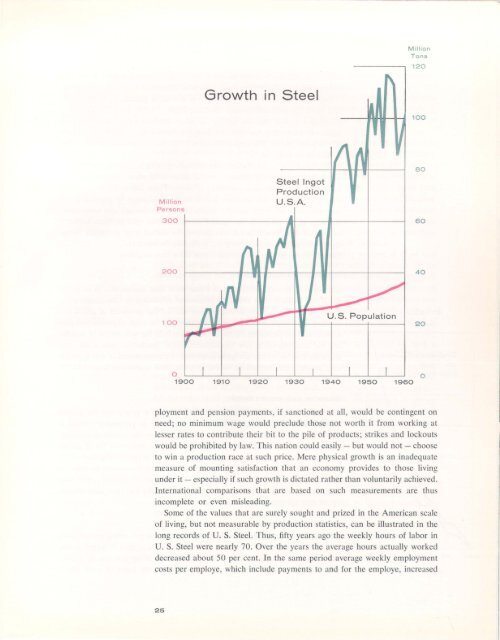United States Steel Corporation
United States Steel Corporation
United States Steel Corporation
You also want an ePaper? Increase the reach of your titles
YUMPU automatically turns print PDFs into web optimized ePapers that Google loves.
Million<br />
Persons<br />
300<br />
200<br />
100<br />
o 1900<br />
Growth In <strong>Steel</strong><br />
1910 1920<br />
<strong>Steel</strong> Ingot<br />
Production<br />
U.S.A.<br />
1930 1940 1950<br />
1960<br />
M illion<br />
Tons<br />
ployment and pension payments, if sanctioned at all, would be contingent on<br />
need; no minimum wage would preclude those not worth it from working at<br />
lesser rates to contribute their bit to the pile of products; strikes and lockouts<br />
would be prohibited by law. This nation could easily - but would not - choose<br />
to win a production race at such price. Mere physical growth is an inadequate<br />
measure of mounting satisfaction that an economy provides to those living<br />
under it - especially if such growth is dictated rather than voluntarily achieved.<br />
International comparisons that are based on such measurements are thus<br />
incomplete or even misleading.<br />
Some of the values that are surely sought and prized in the American scale<br />
of Jiving, but not measurable by production statistics, can be illustrated in the<br />
long records of U. S. <strong>Steel</strong>. Thus, fifty years ago the weekly hours of labor in<br />
U. S. <strong>Steel</strong> were nearly 70. Over the years the average hours actually worked<br />
decreased about 50 per cent. In the same period average weekly employment<br />
costs per employe, which include payments to and for the employe, increased<br />
25<br />
120<br />
100<br />
80<br />
60<br />
40<br />
20<br />
o

















